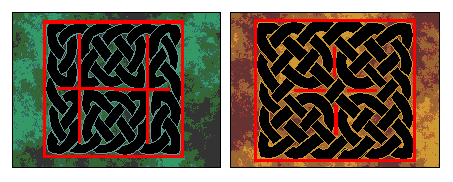|
MIRROR
CURVES |
 |
|
MIRROR
CURVES |
 |
|
The imitation
of the three-dimensional arts of plaiting, weaving and basketry was the
origin of interlaced and knotwork interlaced designs. There are few races
who have not used it as a decoration of stone, wood and metal. Interlacing
rosettes, friezes and ornaments are to be found in the art of most peoples
surrounding the Mediterranean, the Black and Caspian Seas, Egyptians, Greeks,
Romans, Byzantines, Moors, Persians, Turks, Arabs, Syrians, Hebrews, and
with African tribes. Highlights are Celtic interlacing knotworks, Islamic
layered patterns and Moorish floor and wall decorations.
Their common geometrical
construction principle, discovered by P.Gerdes, is the use of (two-sided)
mirrors incident to the edges of a square, triangular or hexagonal regular
plane tiling, or perpendicular to its edges in their midpoints. In the
ideal case, after the series of consecutive reflections, the ray of light
reaches its beginning point, defining a single closed curve. In other cases,
the result consists of several such curves.
|

|
For example, to
the Celtic designs from G.Bain book "Celtic Art" correspond the following
mirror-schemes:
 Trying to discover their common mathematical background, they appear two questions: how to construct such a perfect curve - a single line placed uniformly in a regular tiling, this means, how to arrange the set of mirrors generating it, and how to classify the curves obtained. In principle, any polyomino (polyiamond or polyhexe) with mirrors on its border, and two-sided mirrors between cells or perpendicular to the internal cell-edges in their midpoints, could be used for the creation of the corresponding curves.
For their construction in some polyomino (polyiamond or polyhexe), we propose the following method. First, we construct all the different curves in it without using internal mirrors, starting from different cell-edge midpoints and ending in them, till the polyomino is exhausted, i.e. uniformly covered by k curves. After that, we may use "curve surgery" in order to obtain a single curve, according to the following rules:  In every polyomino we may introduce k-1, k, k+1,..., 2A-P/2 internal two-sided mirrors, where A is the area and P is the perimeter of the polyomino. Introducing the minimal number of mirrors k-1, we first obtain a single curve, and in the next steps we try to preserve that result. In the case of a rectangular square grid RG[a,b] with the sides a, b, the initial number of curves, obtained without using internal mirrors is k = gcd(a,b) (greatest common divisor), so in order to obtain a single curve, the possible number of internal two-sided mirrors is k-1, k,..., 2ab-a-b. According to the rules for introduction of internal mirrors, we propose the following algorithm for the production of monolinear designs: in every step, each of the first internal k-1 mirrors must be introduced in crossing points belonging to different curves. After that, when the curves are connected and transformed into a single line, we may introduce other mirrors, taking care about the number of curves, according to the rules mentioned. For example:
The symmetry of such curves is used for the classification of the Celtic frieze designs by P.Cromwell, and for the reconstruction of Tamil designs by P.Gerdes.
From the ornamental heritage, at first glance appears that symmetry is the mathematical basis for their construction and possible classification. But, the existence of such asymmetrical curves suggests another approach. First criterion that we may use is geometrical one: two curves are equal iff there is a similarity transforming one into the other. This means, that one curve can be obtained from the other by a combined action of a proportionality and isometry. Instead of considering curves, we may consider the equal mirror arrangements defined in the same way. Having the algorithm for the construction of such perfect curves and the criterion for their equality, we may try to enumerate them: to find the number of all different curves (i.e. mirror arrangements) which can be derived from a rectangle with the sides a, b, for a given number of mirrors m (m = k-1, k, ..., 2ab-a-b). The other point of view to the classification of such perfect curves is that of knot theory. Every such curve can be simply transformed into an interlacing knotwork design, this means, into the projection of some alternating knot. The construction
of mirror curves described before is not dependent from the metrical properties
or from the geometry of the surface, so the same principle of construction
can be applied to any tiling (e.g., on a sphere or in the hyperbolic plane).
Let any edge-to-edge tiling of a part of any surface be given. After connecting
midpoints of adjacent edges, we obtain a 4-regular graph. Using the rules
for the introduction of mirrors, it can be converted in a single mirror
curve. Open question: for any tiling, find a general formula for the number
k
of curves, before mirrors are introduced.
Problem: construct a link uniformly
covering given part of a tessellation.
By connecting the midpoints of adjacent
edges we obtain a 4-regular graph.
Separating the components.
By introducing two-sided mirrors
according to the rules mentioned
In the same way,
from those mirror curves we may obtain the corresponding Lunda
designs, etc. All non isomorphic Lunda designs on a regular octahedron
are given at next figure. Open question: enumerate non-isomorphic Lunda
designs obtained from regular polyhedrons.
|